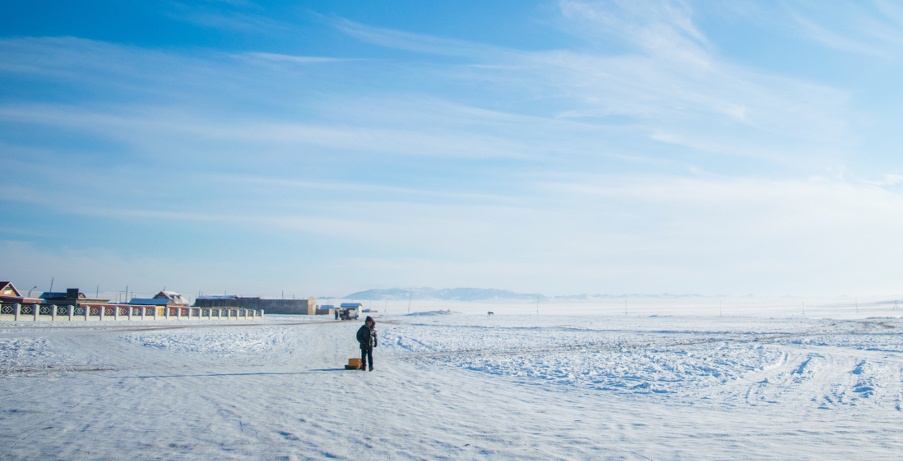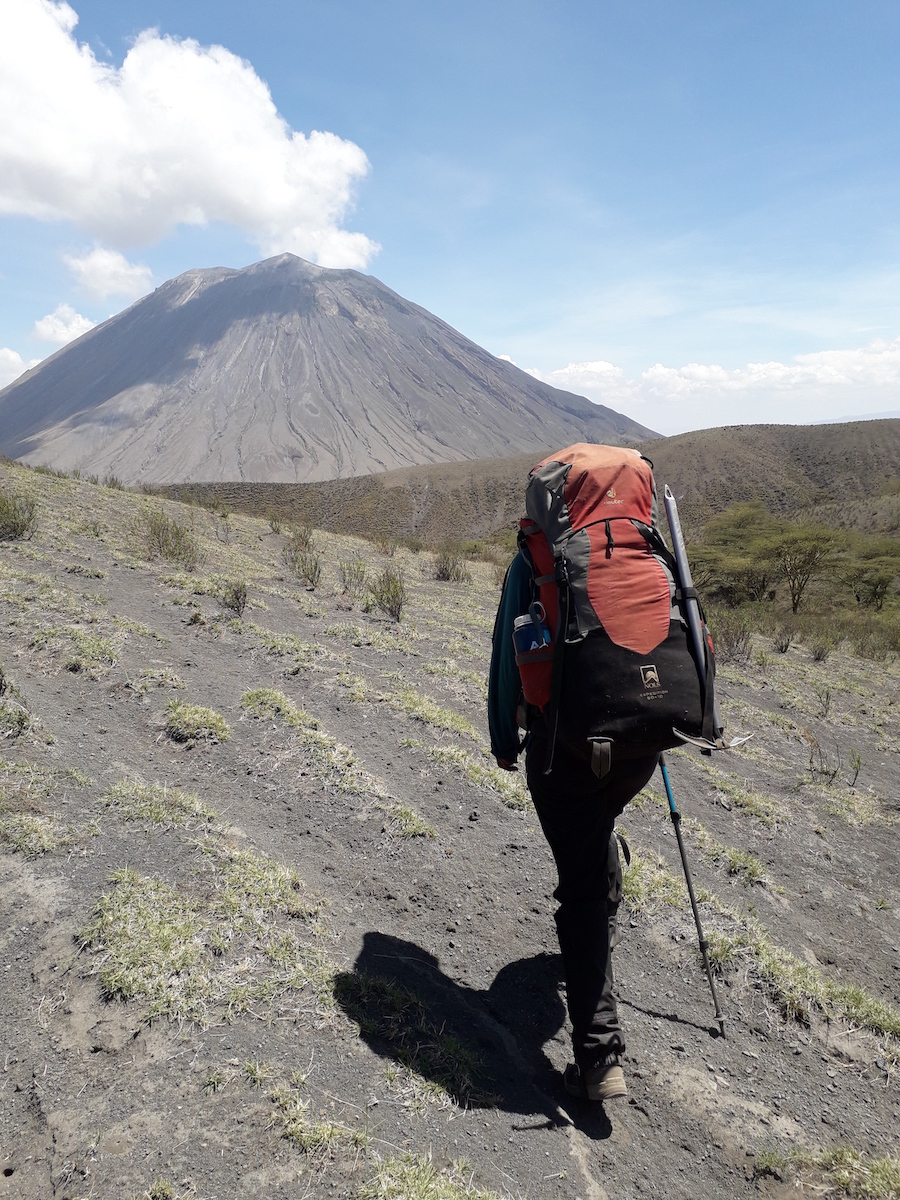NOLS graduate Dimitri Staszewski tells the story of his work recording the songs of Mongolian herders in this excerpt from the spring 2016 issue of The Leader.

Collecting water. Photo by Dimitri Staszewski.
A short five-hour bus ride southeast of Ulaanbaatar, Mongolia’s capital, I found myself ten kilometers outside of Delgerkhaan—a small town of a few thousand people, placed in the middle of a seemingly never-ending swath of steppe. This region was the birthplace of Ghengis Khan (Chinggis in Mongolia) and is famous for its large collection of archeological sites and healing mud baths.
I had come for something different.
My host, Davlaa, and I were going to visit Tsendsuren, an old Mongolian herder, and record her performances of Mongolian long song—a traditional singing style that is becoming harder to find in herder communities.

The door to Tsendsuren's home. Photo courtesy of Dimitri Staszewski.
Entering a Mongolian home, or ger, I have done everything from join a group of Buddhist monks in feasting on boiled sheep, to watch a dubbed version of Quentin Tarantino’s Pulp Fiction. While I have learned to set my expectations aside, I am still continually surprised by what I experience as I travel across Mongolia, recording music in herder’s homes.
Tsendsuren, small, quiet, and smiling, sat opposite me as her daughter Narantuya handed me a bowl of warm milk tea. Her son-in-law Batsaikan offered me his snuff bottle. I reciprocated his actions, accepting the bottle and gently inhaling the snuff. I felt the familiar tingling sensation run up my nostrils as I caught glimpses of Batsaikan’s conversation with my translator. They laughed; usually foreigners start sneezing from the powdered tobacco.
Tsendsuren sat patiently as we politely shifted the conversation from pleasantries and small talk to the reason why we had come. It would be jarring, and rude, to walk into someone’s home and immediately ask them to sing.
Shy and humble, Tsendsuren initially laughed off my request in a loving manner only older people can muster. Slowly, she warmed to the idea, but insisted her grandson bring her nice deel to wear during the performance.
He helped her button the long overcoat before she tied its silk sash around her waist and wrapped a colorfully decorated bandana around her head. We helped Tsendsuren stand up. Her back arched forward as she took small steps toward a seat in front of the altar where she would perform.
I attached a small microphone to Tsendsuren’s collar and positioned her in front of my camera. Her eyes were bright and smiling as the atmosphere shifted to focus completely on her. Motioning for her to begin, her soft but powerful voice filled the ger.

Tsendsuren preparing to sing. Photo courtesy of Dimitri Staszewski.
I’ve grown familiar with my process. Several weeks of planned, or often chance, meetings lead to phone calls, which lead to brainstorming, research, and note scribbling. To-do-lists lead to ticket buying, supply gathering, equipment checking, battery charging, and eventually bag packing.
When the day finally arrives and the trip begins, the journey has already been long underway.
For those of us drawn to exploring the outdoors, this type of process is welcome and routine. We find comfort in it. It provides focus. The details might differ slightly, camp stoves and rations replaced with cameras and memory cards, but the feeling of growing anticipation as the expedition approaches is the same.
Part of my process is to revel, to continually be astounded by the honor of someone singing for me. I would be foolish to take any performance for granted, or to act like I deserve or am entitled to it.
As a performer begins to sing for me, while I am there to record, preserve, and share their performance with the world, I must also set aside those grander imperatives and simply appreciate the single performance I am witnessing.
Tsendsuren’s voice was beautiful. She transitioned from powerful vibrato to soft whispers as elongated syllables formed her long song. While her singing was special, her performance was elevated by her story.
Tsendsuren is 79 years old and represents a group of herders who have seen the world change drastically in front of their eyes. Her mother gave birth to her in the field outside their ger. She remembers fishing next to Soviet soldiers when she was little. When she caught a fish, she would always run home right away because she was so excited. “The lake used to be rich with fish,” she said, “but now it’s getting scarce.”
At the same time, herders with Tsendsuren’s musical experience are dwindling. When Tsendsuren was young, an old woman would sing with her. When her informal teacher died, Tsendsuren stopped learning new songs. She used to sing all the time when she was young. Now, she says, “I am forgetting some of the songs.”
While this was sad to hear, it validated being there to record. Traditional music will remain part of Mongolian culture with or without the existence of nomadic herding. New generations of aspiring Mongolian musicians still learn traditional singing styles, and professional musicians continue to perform in front of large audiences.
Yet performances by herders exhibit something staged performances by professional musicians cannot. Herders sing about actions they carry out on a daily basis, the environment they inhabit, and use songs as tools to calm and train their animals.

Recording an outside performance. Photo courtesy of Dimitri Staszewski.
When I talk with older herders, many repeat the sentiment fewer people sing in the countryside now than when they were growing up. Most herders I speak with attribute this change to an access to new forms of media.
With solar powered television sets in most countryside gers, and an ever-growing data network, singing after a long day of herding doesn’t carry the same entertainment value it once did. Instead, young herders catch the most recent episodes of Mongolia’s Got Talent and check their Facebook pages when they go into the nearby towns.
After recording one song, Narantuya persuaded her shy husband to perform a song all together. Putting on matching formal deel, they joined Tsendsuren by the altar.
As they began to sing, their performance took on an elevated significance. Individually, we came to the unspoken understanding Tsendsuren would not be around much longer.

Tsendsuren with her family. Photo by Ochirkhuyag Myagmardorj.
While Tsendsuren may regret not mentoring a young singer, she has clearly passed along some of her musical knowledge to her daughter. I listened as I filmed their family singing together. I was honored to help capture this moment.
I felt proud as I left Tsendsuren’s ger. Not only had I preserved performances by an amazing singer, I had given her family an opportunity to sing together and to capture a moment they would cherish forever. I will send them a copy of their performance.
I ask a lot as I enter a stranger’s home and ask them to sing for me. While I bring tokens of my appreciation, I do not feel it is always possible to return the favor. Leaving Tsendsuren’s ger, I felt as if we had both been able to give each other something precious.
It has become so easy to share our experiences with friends, family, and strangers as we post pictures of our peak ascents and sunset hikes online. I fall into the trap myself.
As we explore the wild parts of the world, paddling rapids, braving thunderstorms, or recording music in the Mongolian countryside, it is important to remember our journeys do not begin or end with those moments. By making time to search for and appreciate each step in our process, we can gain a greater appreciation for the places we’re exploring and the people who are a part of those journeys.
Written By
Dimitri Staszewski
Dimitri is a recording engineer, producer, and an adventurer who enjoys merging his passions for creating multimedia content and exploration. That mindset has led him to work in the Mongolian steppe, renowned recording studios in New York, San Francisco, and New Orleans, a dude ranch in Colorado, and as an and Outfitting Assistant at the NOLS Rocky Mountain Branch. He participated in a NOLS Southwest Semester during the fall of 2011. Dimitri is performing his work in Mongolia on a Fulbright-mtvU scholarship, adding to his online archive of traditional Mongolian music on mongolmusicarchive.com and Vimeo. The website aims to capture and preserve uses of traditional music in the daily lives of herders.




